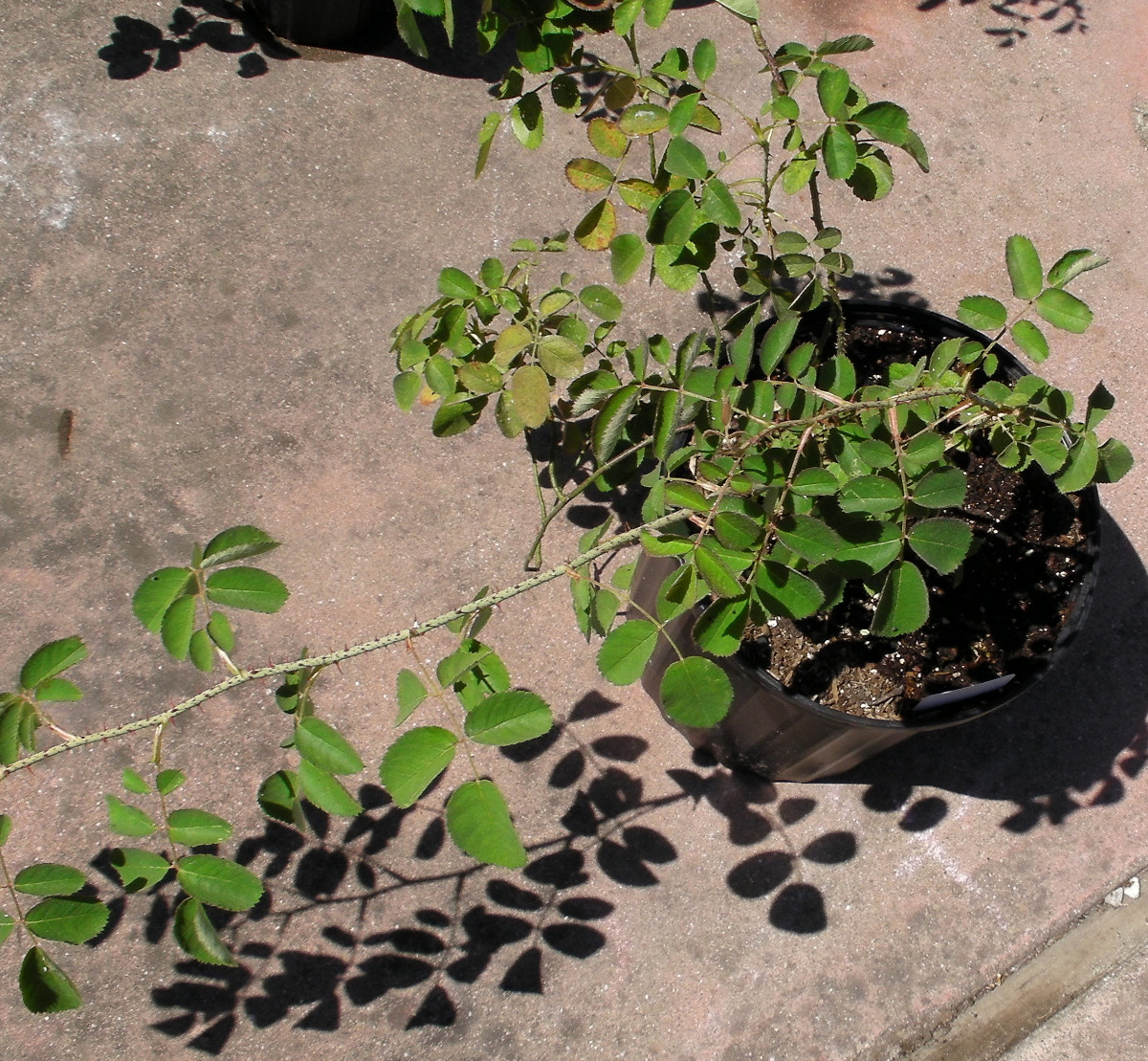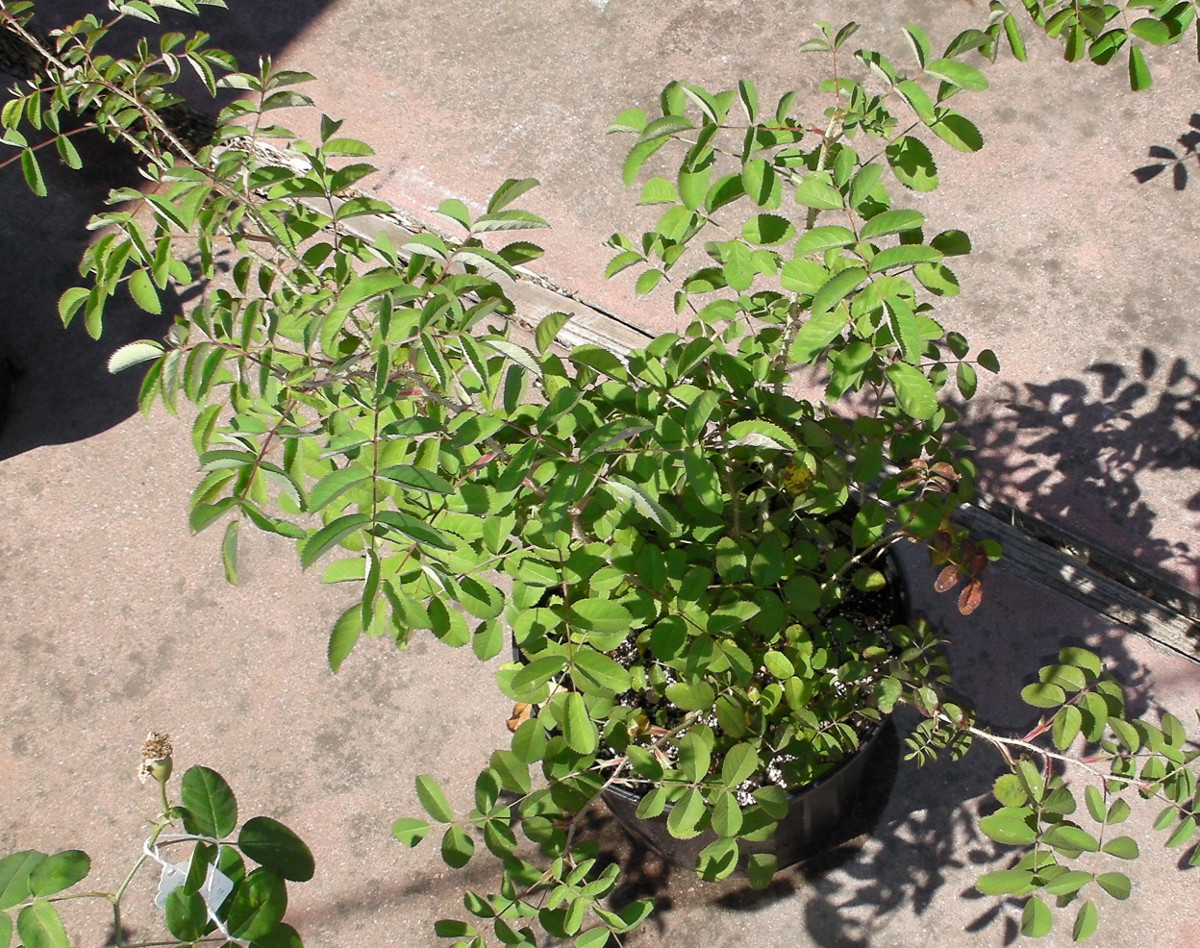This aren’t a whole lot of people breeding these anymore, but I’d hope that others who have bred them will contribute what they can, so that those who want to try it in the future will have a good place to get started.
We don’t know for sure which was the original R. damascena, that probably originated somewhere between the western slopes of the Himalayas and northeastern Persia a few thousand years ago, but most all of the thorny primitive types have been found to be genetically indistinguishable, so they are either the original, or sports of the original. All of them pose problems for the breeder, but they aren’t insurmountable.
Early Damasks are good pollen producers, but barely lukewarm as seed bearers. Not all pollinations will set, and of those that do, some will produce empty hips. Almost all hips which are not empty will contain one achene, and only once have I seen three in one hip. Plants that are not well established, or underwatered, may not produce any seed. Big, established plants, on the other hand, are hard to pollinate without running into a lot of thorns. When left to the bees, mine produced quite a few selfings, but others which clearly were hybrids. Maybe a quarter of them mildewed badly, as is a problem with a great many kinds of rose seedlings, but the majority were reasonably healthy, and survived conditions which killed the babies of most other roses I was breeding. Healthy seedlings is probably the only aspect of using old Damasks as seed parents which seemed very encouraging to me.
Reblooming Damasks don’t pass along their remontancy like more modern, juvenile rebloomers do, and I know of no rule of thumb to say how many seedlings will have to be grown out to get a repeater. Generally speaking, the answer seems to be LOTS. Paul Barden mentioned a dwarf seedling of Autumn Damask he’d been given, which may have been a selfing, and which repeated, but most of my Autumn Damask selfings look much like the original, so if it is possible to get repeaters that way, it’s hard to see why anyone should prefer them to their parent.
Portlands and other hybrids of the original damascena are often better seed parents, but most aren’t by very much. Duchess of Portland, for example, sets hips a bit more frequently (though many abort), and they’re empty less often, but still only produces 2-3 seeds per hip, and reblooming seedlings are too rare for me, or any living person I know of, to have grown any. Pickering Four Seasons gave me a lot of impressively big hips, orange and showing Damask influence in their shape, but most have been empty. A large and happy specimen of Duchesse de Rohan produces a useful amount of pollen, but will never set a hip. I’ve heard that Indigo will set hips, but mine hasn’t yet. Stanwell produces a little pollen, but almost never any seed.
Of once-blooming Damask hybrids, Mme Hardy is famously sterile, producing only empty hips, and never more than a tiny trace of pollen. Ispahan makes plenty of fertile pollen, but no hips. Hebe’s Lip is relatively fertile in both directions; almost all pollinations set, it rarely aborted, and it never made empty hips for me, but how many seeds you will get seems to depend a lot on luck and the pollen used, and it may not be very many. On some pollinations I got as many as half a dozen seeds, but usually only two or three. Saint Nicholas, which (like Hebe’s Lip) shows eglantine traits in its foliage and thorns, produces fewer flowers, and thus fewer hips, but set is reliable and the seed count per hip is more like 15-20. Its hybrid seedlings were not especially healthy for me, though a few weren’t bad, and its selfings were often disease resistant. It doesn’t smell much like a Damask however, and I don’t think it really fits into the class. Celsiana seems as much an Alba as a Damask, but produces plenty of pollen and seed, averaging around 5 per hip with decent germination, though seedling health can be expected to be variable. Petite Lisette produces little pollen and no hips. I haven’t yet tried breeding Leda, but suspect it would act like pure damascena. I also haven’t tried breeding my Botzaris or Blush Damask, but have no reason to believe they’ll be very fertile.
To sum up, unless one wants to use Celsiana, or maybe Hebe’s Lip, Damasks are probably best used as pollen parents. But on what?
In days of old, they would use gallicas, which are mostly better seed producers. Hortensia can be counted on for 1-2 seeds per pollination, Ipsilante and Alika for 2-3. Apothecary’s Rose/Rosa Mundi and Tuscany Superb did more like 4-8 seeds/hip for me, but seedling health was no better than with Celsiana, and most people are probably not wanting to recreate Duchess of Portland from scratch.
Albas are fairly fertile in some climates, but not so much where I live, plus they usually take a long time to germinate, and then you’ve got ploidy issues to deal with. Canina and eglanteria are more fertile, but the germination and ploidy problems are similar.
Centifolias make seed in Pakistan, but in more temperate climates produce very few hips which aren’t empty.
Musk x Damask is something I’ve just tried, but I don’t expect that to be any easier than using damascena as a seed parent, if it works out at all.
I’ve heard that some moderns don’t take damascena pollen very readily, but haven’t really tried that route myself. (I figured that, with my luck, I’d get tea scented once-bloomers with the thorns and growing habit of damascena. Those who are less pessimistic might want to give it a go.)
One possibility is to try backcrossing it with fedtschenkoana, which is more hip fertile in some environments, and would give a chance of rebloom in F1s. Another, which I’ve been doing a lot of this year, is to use Damask/Portland pollen on HPs, some of which are quite fertile, and most of which have much better chances of passing along rebloom, though it will require two generations.
I’ve put Damask and/or Portland pollen on the following, with reasonable hip set, at 8-20 seeds per hip:
Rose du Roi “(of commerce)”
Marbree
La Reine (also “Barbara’s Pasture Rose,” which is very similar)
Reine des Violettes
Alfred Colomb
While one of the old authors noted that a breeder had grown out thousands of seedlings of Rose du Roi without producing any rebloomers, it isn’t 100% clear whether his rose was identical to what gets called that nowadays, nor was anything said about what pollen he was using. Were he, for example, treating an early HP as having Damask rebloom, when its rebloom was from chinensis, he could certainly cross it with something like The Portland Rose and get no rebloomers. The rose that is usually sold as Rose du Roi in the US will bloom for me in December, and produces ovoid or spherical hips that are quite large and purple, traits which make me suspect lurking chinensis. I won’t be able to comment on rebloom among descendants for a few years, however.
Marbree also makes way too many seeds for a Damask, or even a Gallica, and Paul Barden said he got one rebloomer out of five or six of its seedlings, so I think, given its late introduction date, that it’s got some chinensis ancestry. Its scent is not terribly strong, or exactly the typical Portland fragrance, but using it to get more rebloom and female fertility into Damasks without going too far out of class seems like a real possibility, and I’m enthusiastic about trying it for that purpose.
The others are clearly much purer chinensis, but all have gotten decent hip set using pollen from Portlands, and make a lot of seed. Though La Reine is finicky and sickly in many environments, it does have a reputation for lots of rebloomers among its offspring, so try it if you dare. Reine des Violettes is less disease prone but nearly as demanding, less prolific, and set hips less consistently. Alfred Colomb has been healthy for me, and produced 10-12 seeds from nearly every pollination, if you don’t mind growing yet more descendants of Gloire des Rosomanes.
Comte de Chambord produced somewhat less seed than those, and Baronne Prevost only a few seeds per hip, but both are worth a try. Vick’s Caprice also took Portland pollen, but didn’t set hips very consistently, though that may have been the drought at work. Eugene de Beauharnais is only just now deciding to bloom, but I’m hoping it will like Duchesse de Rohan pollen, because that’s what it’s getting. It hasn’t produced much seed for me in the past, but I haven’t quite given up on it yet. Rose de Rescht has also been a disappointing seed producer for me, and has a reputation for sickly seedlings, but I’m still trying.
The only HPs which utterly failed were Glendora, which is about as sterile as Mme Hardy, and the rose I got as Jacques Cartier, which produces some pollen but no hips. In neither case can I fault Damask pollen, they’re just not made to be mothers.
Other possibilities which I haven’t tried much, since the seed parents don’t do very well here, are Moss x damascena, and rugosa x damascena. The latter could make an interesting security rose, and for all I know, might even have a chance of rebloom in the first generation.
I did 46 crosses involving roses discussed in this post this year, so hopefully will have more to add several months from now.




